
Moving organizational energy use toward 100 percent renewables—aspiration or destination? Insights from the Deloitte 100 Percent Renewable Transition Survey
26 minute read
02 October 2019
The US clean energy movement is gaining strength—more organizations are aiming to increase renewables in their energy mix and reduce carbon emissions. The Deloitte 100 Percent Renewable Transition Survey looks at what this means for organizations on this journey to 100 percent renewables.
Introduction
The clean energy movement is alive and well in the United States. While the country lacks a national policy to address climate change, a growing list of states, cities, and public and private sector organizations is setting increasingly ambitious goals to transition to renewable energy.1 We Are Still In. We Mean Business. Mayors for 100 Percent Clean Energy. These and other US-based groups devoted to the transition are growing. Almost every week, another company or organization announces its goal to reach 100 percent renewable energy.
Learn more
Explore the Power, Utilities & Renewables collection
Read the related blog
Subscribe to receive related content from Deloitte Insights
Download the Deloitte Insights and Dow Jones app
Check out the infographic and podcast
Even though most organizations are not targeting 100 percent, a rising share aims to increase the percentage of renewables in their energy mix to 25 percent, 50 percent, or more over time. Others have set goals to reduce carbon emissions, making renewable deployment a vital prong in their strategies too.
As of mid-2019, about a dozen states have renewable portfolio standards of 50 percent or more.2 This includes 100 percent renewable goals in Hawaii and Maine, as well as the District of Columbia and the territory of Puerto Rico.3 A few more states have 100 percent “clean energy” goals, which include renewables and other carbon-free energy sources. Not to be outdone, over 100 US cities have also committed to achieve 100 percent renewable energy by specific target dates—and a handful have already succeeded.4 State and municipal goals often reflect efforts to align with the 2016 Paris Climate Agreement goal of limiting global temperature increases to 1.5 degrees Celsius (2.7 degrees Fahrenheit).5
And finally, as one of the sturdiest engines driving renewable energy growth in the United States and globally, US corporations have signed power purchase agreements (PPAs) for 5.9 gigawatts (GW) of renewable energy in the first half of 2019, up from 4.4 GW for the same period in 2018.6 The 2018 US total was 9.1 GW, rising from just 0.6 GW in 2015.7
All of this comes against a backdrop of rapidly falling costs for wind, solar, and the battery technology to store it, as well as societal shifts in the arena of public opinion, market, financial, and regulatory forces. Consumers, employees, citizen activists, government and intergovernmental organizations, as well as investors and financial regulators, are increasingly shining a spotlight on energy sourcing (see sidebar, “Stakeholder expectations are pressuring organizations to act”). As economic incentives and external pressures mount for organizations to decarbonize their energy supply, the transition to renewable energy gains steam.
In the Deloitte Resources 2019 Study, about half of the companies surveyed sought to add more renewable energy to their mix.8 This report focuses on a new study, the Deloitte 100 Percent Renewable Transition Survey, which shines the light more closely on US organizations’ paths in the transition to renewable energy. The commercial, industrial, and transportation sectors account for nearly 80 percent of US energy consumption.9 This study explores what the journey looks like for a broad cross-section of organizations in these sectors and examines the differences across industry groups, starting with their goals and drivers. It analyzes the strategic focus across industries and discusses the challenges organizations face in renewable procurement and in expanding electrification of energy end uses. And finally, it examines the role electric utilities can play to help organizations meet their goals and discusses some of the wider enabling factors in the developing ecosystem. We surveyed organizations in a variety of industries in both the private and public sectors across the United States (see sidebar, “Deloitte 100 Percent Renewable Transition Survey”).
Deloitte 100 Percent Renewable Transition Survey
To understand the renewable energy goals and procurement strategies of organizations across multiple industries in the private and public sectors, Deloitte fielded a survey of 308 executives across the United States in August 2019.
The survey captured insights from respondents in eight industry groups: Industrials, Manufacturing, Health care/medical, Banking and financial services, Technology and Telecommunications, Consumer Products and Services, Education and Government, and Other Services. See the appendix for a detailed breakdown of the industries within each of these groups.
- All organizations surveyed had annual revenue of more than US$ 1 million, 55 percent had revenue exceeding US$ 100 million, and 20 percent had revenue more than US$ 1 billion.
- Respondents were C-suite executives (52 percent), executives (23 percent), managers (20 percent), and others (5 percent).
Setting goals is the first step in the renewable transition
The most common goals among the organizations surveyed are those often seen as the first steps in the renewable energy transition: to reduce overall energy use and boost energy efficiency. Nearly half of the respondents said they are working toward each of these goals (figure 1). The third-place goal, after building this foundation, is to increase renewables’ share in their energy use. Almost 45 percent said their organization is committed to sourcing a specific percentage of their electricity from renewable resources by a target year. Targets varied significantly by amount and target year, and six respondents (2 percent) said their organizations are aiming for 100 percent renewables.
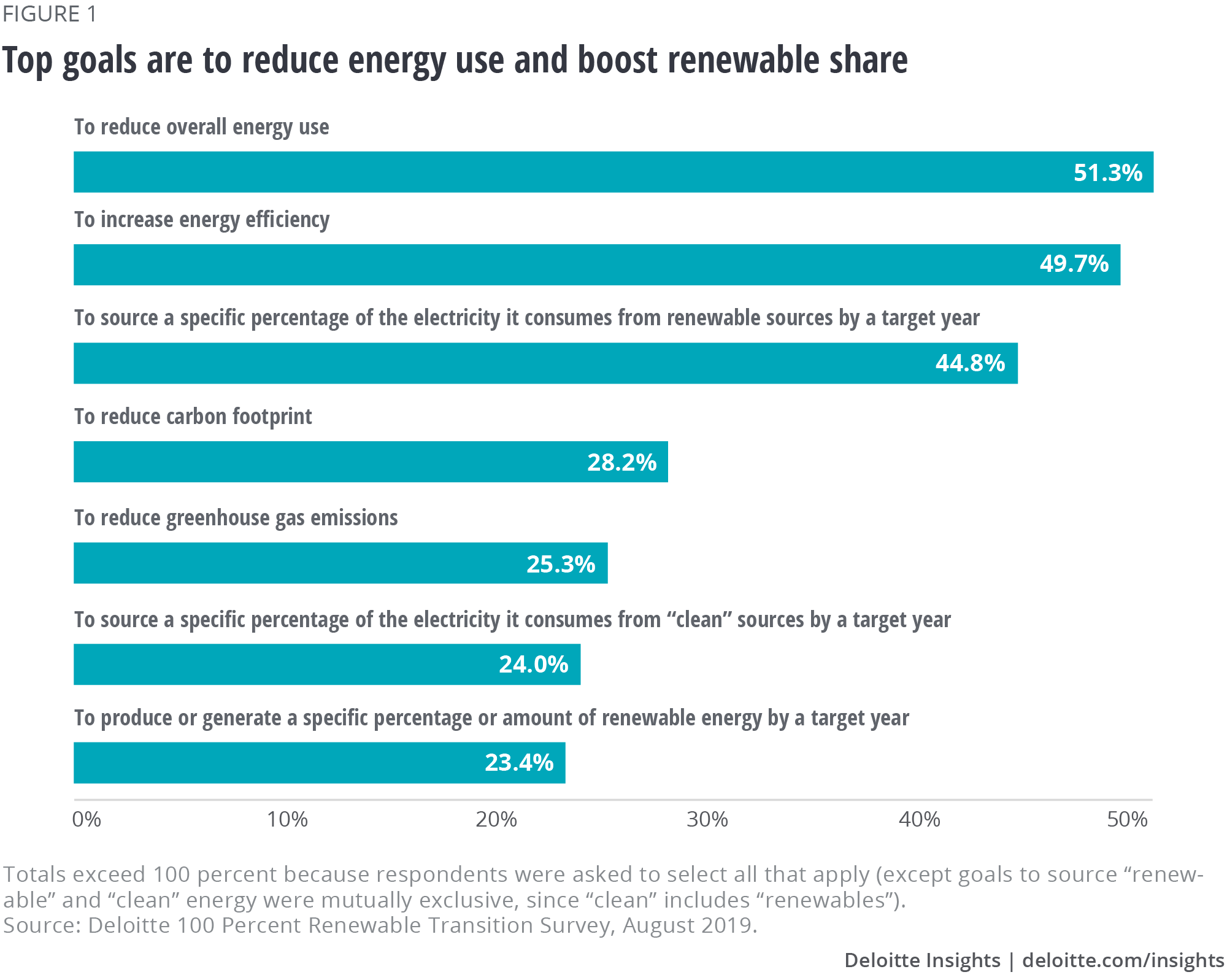
One technology and telecommunications industry respondent reported having already achieved the 100 percent goal in 2015, while the most distant target year for a 100 percent goal was 2050, in the banking and financial services industry. Respondents from the consumer products and services, manufacturing, and health care/medical groups had the highest concentrations of renewable goals targeted for the period 2020–25, while technology and telecommunications industry goals extend through 2045, but are concentrated before 2030. Banking and financial services respondents’ target years were the most evenly spread between 2020 to 2050.
Rounding out the top five goals are the commitment to reduce their organization’s carbon footprint (28.2 percent) and to cut overall greenhouse gas emissions (25.3 percent). To achieve these types of goals, even those who did not report specific goals for renewable electricity will still likely need to increase renewable procurement. In fact, of those who did not report a renewable target, nearly 60 percent said their other energy-related goals could cause them to boost renewable energy use.
In addition to those seeking to increase renewable energy, nearly a quarter of respondents reported a goal to source a specific percentage of “clean” energy by a target year. Clean energy most often means that carbon-free sources, such as nuclear energy, are counted in addition to renewables. These goals dovetail nicely with several recently announced state goals (Washington, Nevada, New Mexico, and Colorado) to add a 100 percent clean energy standard to their existing renewable portfolio standards (RPS).10
A growing number of electric utilities are also committing to significant carbon reduction and renewable energy use. At least 10 utilities have announced 100 percent decarbonization goals11 and many others have set goals to reduce carbon emissions by as much as 80 percent below 2005 levels by 2050.12
It is also noteworthy that nearly a quarter of the survey respondents have a goal to produce, or generate, a specific percentage or amount of renewable energy by a target year. This production goal (as opposed to a consumption goal) is an option for companies that invest in onsite or offsite renewable generation projects and may produce renewable electricity beyond what they consume, with the excess being fed into the grid for other customers.13 This was most common in the education and government, consumer products and services, and other services respondent groups.
Of all groups, respondents in the health care/medical industry most often reported goals to source a specific percentage of their electricity from renewables, at nearly 61 percent. This may be due to multiple priorities in the health care sector (see sidebar, “Health care sector applies ‘First, do no harm’ oath to energy use”).14
Health care sector applies “First, do no harm” oath to energy use

Health care is an energy-intensive industry—and one challenged by a relatively large carbon footprint, rising costs, and a growing imperative for resiliency. Many organizations seek to address these challenges by pursuing goals that often include sourcing more renewables:
- Reducing carbon emissions: Contributing about 10 percent of US carbon emissions and 9 percent of non-greenhouse gas air pollutants means the health care sector may also be contributing to the adverse health impacts of climate change and air pollution.15 Many health care organizations see this as inconsistent with their overall mission to promote health, and to medical students’ oath to “First, do no harm.” As a result, many are pursuing broad sustainability agendas, including goals to source more renewable energy.
- Managing costs: One of the most significant challenges facing the health care sector is the rising cost of care, and rising energy costs are part of the equation.16 Promoting energy efficiency and deploying renewables that are not only cleaner, but usually cheaper, than conventional sources can help control these costs, increase price transparency, and reduce risk.
- Pursuing resiliency: Many health care facilities need uninterrupted power 24/7/365. Scenes of urgent evacuations during severe weather events in recent years have driven home the high stakes involved. Many states and cities are working with critical facilities such as hospitals to deploy microgrids that will ensure power supply during emergencies. And some health care organizations, such as RE100 member Kaiser Permanente, are considering solar-plus-storage as one of the potential backup solutions for medical buildings.17
In fact, many organizations are starting to go beyond boosting renewables in their electricity supply to electrifying other energy end uses—and using renewables to power those as well, as discussed further in the section entitled “Strategies for the transition: Exploring the ‘What’ and the ‘How.’”
Sustainability integrates renewable energy drivers
The concept of sustainability typically integrates all of the renewable energy drivers reflected in figure 2. Sourcing renewable energy can promote sustainability by driving long-term value through:
- Cost reduction: Solar and wind are increasingly becoming the lowest cost energy sources, and the cost of battery storage to help manage their intermittency has fallen 85 percent since 2010.18
- Risk mitigation: Renewables can reduce energy supply risk, price risk, and potential reputational risk due to societal shifts (see sidebar, “Stakeholder expectations are pressuring organizations to act”). They can also reduce policy and regulatory risks from potential future policies, such as a carbon tax and market transition toward a low-carbon economy. And finally, there’s increasing pressure to disclose and address climate-related financial risk, particularly as credit rating agencies prepare to assess it.19
- Revenue generation: Organizations can potentially earn revenue from selling excess renewable energy generated or renewable energy credits (RECs). In some cases, they can also accrue tax credits or earn rebates for investment in renewable energy, energy efficiency, EVs, and EV charging infrastructure.
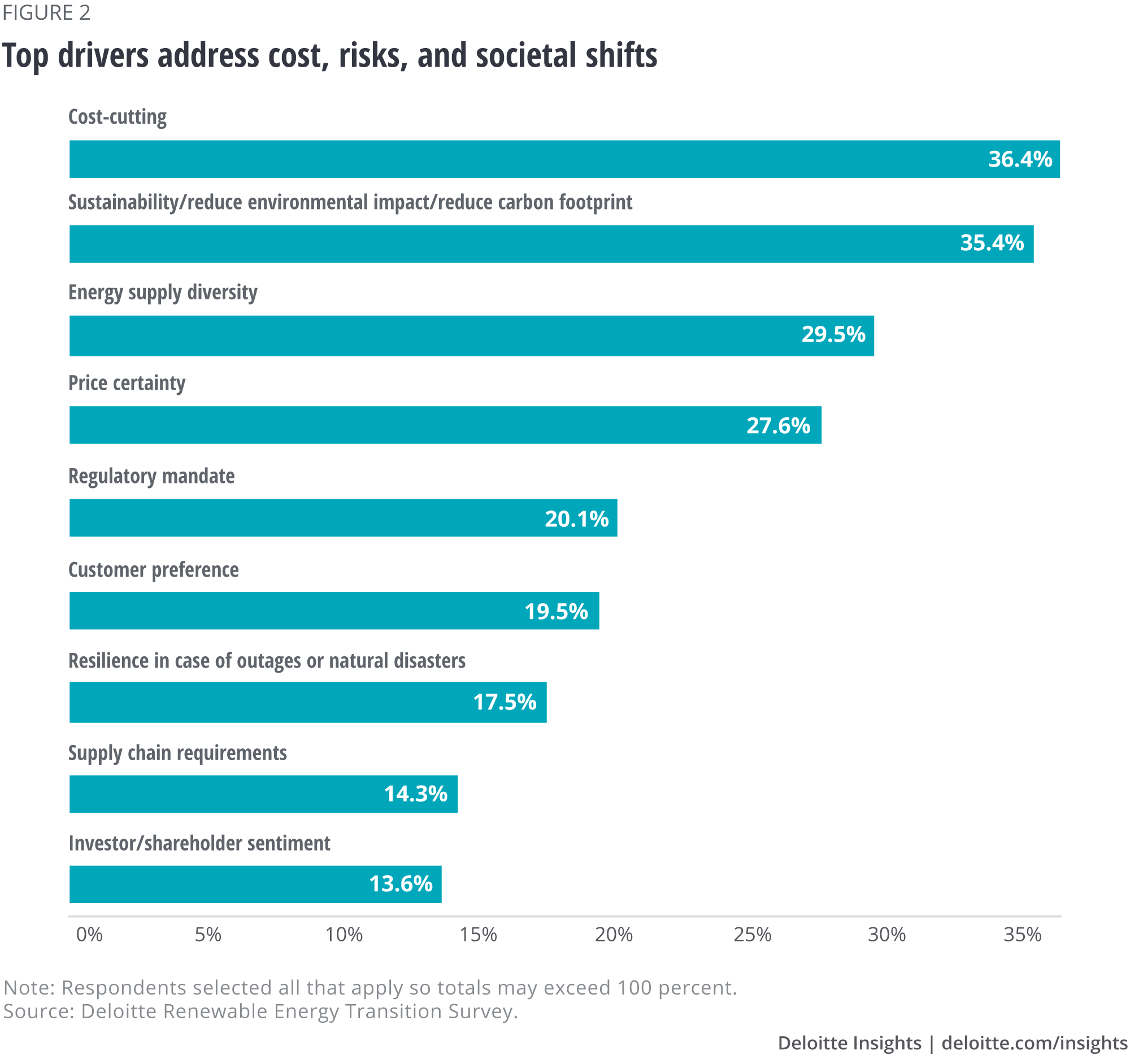
Survey respondents selected “cost-cutting” as the top driver of their interest in renewable energy. Energy customers have long appreciated renewables’ carbon-free attributes. But it’s only recently that wind and solar costs have dropped far enough to drive energy savings. Right behind cost, respondents signaled the desire to reduce environmental impact and carbon footprint.
The next three drivers in figure 2 reflect efforts to manage risks: by diversifying supply, locking in prices, and complying with regulatory mandates. Following that is customer preference, and at the bottom, investor sentiment. These drivers are part of the evolving stakeholder expectations that are causing societal shifts and driving organizations to act (see sidebar, “Stakeholder expectations are pressuring organizations to act”). In response, many organizations are developing new environmental, social, and governance (ESG) strategies, including sourcing cleaner energy.
Stakeholder expectations are pressuring organizations to act
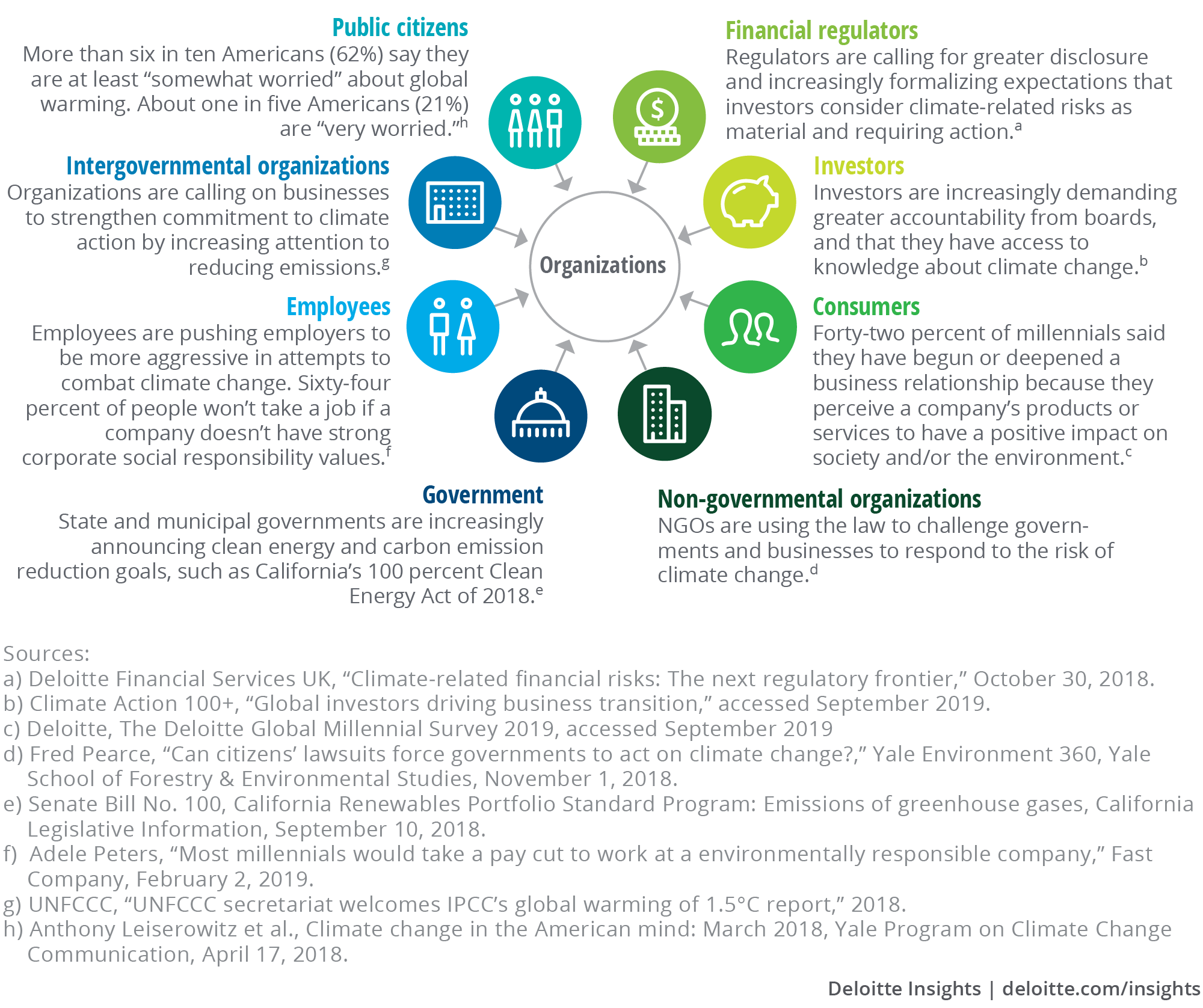
The specific drivers that individual industry groups emphasize may reflect the unique characteristics and priorities of those groups. For example, the industries that most often chose cost-cutting as the top driver were consumer products and services and education and government. This may stem from the highly competitive nature of the consumer products and services industry and generally limited budgets in education and government. Respondents in the technology and telecommunications industry group were least likely to choose cost-cutting. While 26 percent of that group did select cost-cutting, two drivers that were even more important to them were energy supply diversity and reducing their environmental impact. The importance of supply diversity in this sector is well-known due to their energy-gulping, 24/7, critical data centers. In addition, many technology companies have wrapped environmental commitment into their branding.
Strategies for the transition: Exploring the “What” and the “How”
While there is no fixed recipe for the journey toward 100 percent renewables, energy consumers typically follow a three-step approach:
- Reduce electricity demand through energy conservation and efficiency initiatives.
- Boost the percentage of renewable energy in their electricity supply, with some aiming for up to 100 percent.
- Convert energy end uses that are not currently electrified, and often run on higher carbon fuels, to electricity—and then source renewables for that electricity. These end uses generally span three categories: transportation fleets, heating and cooling systems, and industrial processes.
As organizations boost procurement and investment in renewable energy, the strategies they adopt depend on their holistic approach to the overall transition and the path they choose. This is reflected in their renewable energy goals as well as the sourcing models they choose to procure renewables, essentially the “What” and the “How.”
Deloitte developed a Renewable Transition Framework to classify some of the strategies across industry groups based on insights from the Deloitte 100 Percent Renewable Transition Survey and secondary research (figure 3). The Renewable Transition Framework maps respondent industry groups based on their strategic choices along two axes: the x-axis, which represents what they are doing (the “What”), and the y-axis, which represents how they are doing it (the “How”). Details on industry groups are in the appendix.
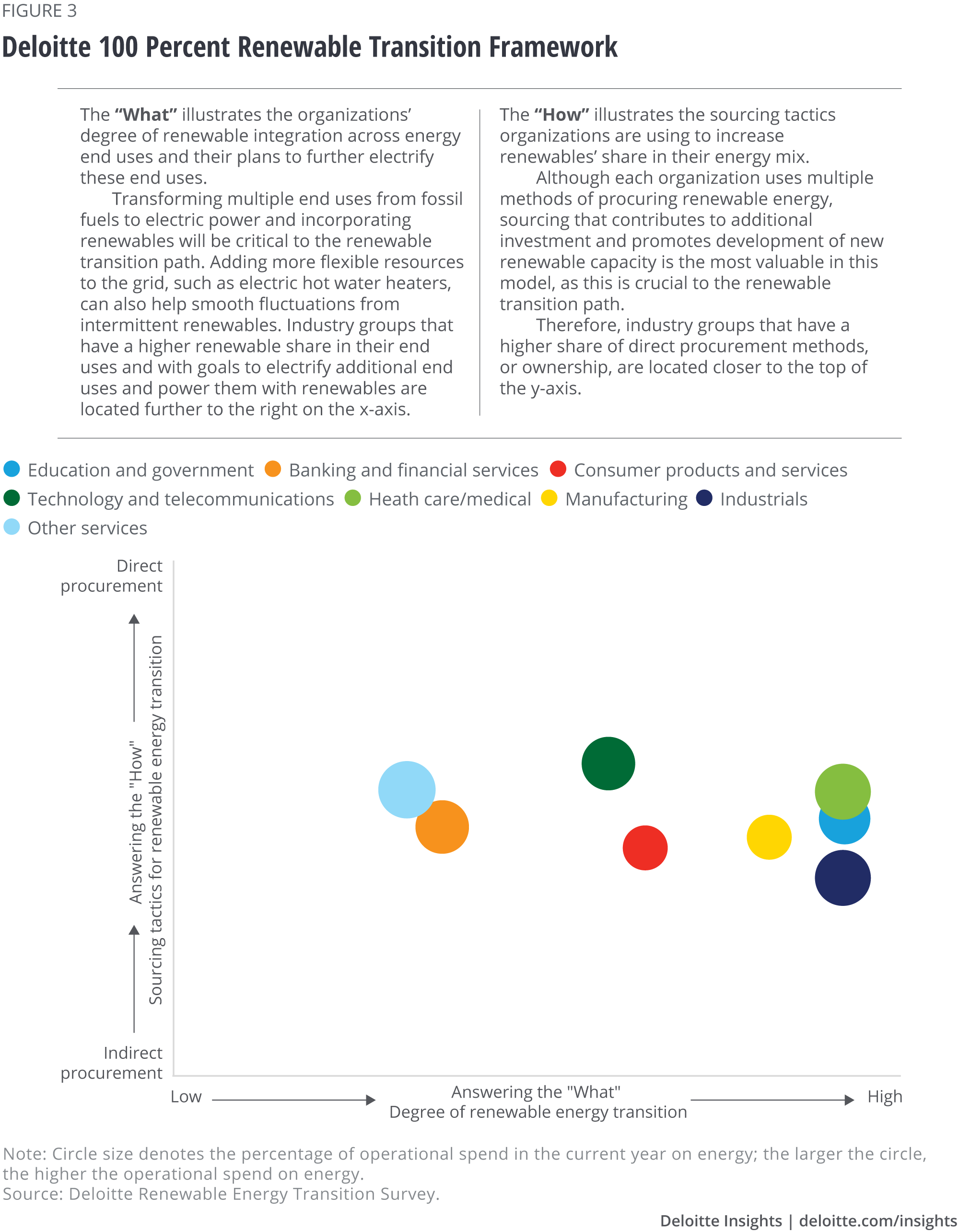
The following discussion will explore the “What” and “How” strategies organizations are pursuing in the renewable energy transition, including survey results, notable examples from industry groups, and broad emerging themes.
We’ll start with the “How,” since this is where most organizations focus first—on how they can boost renewables’ share in their electricity mix. It’s often at a later stage that organizations shift focus to the “What,” as they seek to electrify more of their energy end uses, such as space and water heating, transportation, and industrial processes, and power them with renewables too.
Exploring the “How”
Although there is no one-size-fits-all transaction to meet the varying energy needs of different industry groups, each organization treads the renewable energy path that most suits it. In fact, multiple pathways are available to procure renewable energy—from unbundled RECs to outright ownership of renewable energy projects. Organizations’ sourcing tactics have evolved and now often tend to be a mix of the different options available.
Over the last decade, it’s been common for organizations to purchase and sell unbundled RECs to reduce their carbon footprints. However, since this does not necessarily support additional project development, organizations are increasingly seeking “additionality” in their investments. As a result, in recent years, many industry groups have been exploring new purchasing options—from utility green tariffs to more direct instruments such as power purchase agreements (PPAs), and renewable energy project ownership.
The technology and telecommunications group is among the most active industry sectors in renewable procurement, and one of the furthest advanced on this journey. Respondents in this group said about 71 percent of their renewable electricity purchases are through active sourcing, including onsite renewable resources, increasingly with battery storage. Google, for example, has matched 100 percent of its global energy consumption with renewable energy purchases for two consecutive years (2017–18).20 While they’ve bought renewables mainly through PPAs, they have also worked with utilities in four states on programs to purchase renewable power. Such programs pave the way for other organizations to procure renewables as well.21
Three developing themes in the set of “How” strategies are:
Direct procurement of renewable energy is an increasingly popular choice for most industry groups
Organizations are moving from indirect forms of procurement, such as unbundled RECs, to direct procurement, such as self-generation and PPAs, which directly enable the financing of a new renewable electricity asset.22 In our survey, 57 percent of respondents reported ownership of renewables and 80 percent chose PPAs (physical and virtual) as their key procurement strategies.
Innovative contracting structures have enabled organizations to procure renewable energy from offsite solar installations cost-effectively. Virtual power purchase agreements (VPPAs)23 are the preferred instruments for buying offsite renewables for most industry groups. In the first half of 2019, VPPAs accounted for 82 percent of all US deals (5.95 GW total deal capacity).24 In August 2019, Gap Inc. signed a 90 MW VPPA with Enel Green Power North America, making it one of the largest agreements by an apparel retailer.25
Although late to the game, utility offerings such as green power products and green tariffs have expanded the renewable purchase pool
Many utilities offer green power products26 and green tariffs27 that allow small and large organizations to increase their investment in renewable energy. For large organizations located in regulated states, green tariffs are innovative instruments that have expanded opportunities for them to buy renewable energy through regulated utilities. Twenty-three green tariffs in 17 states have been proposed or approved, with two denied by the states’ public utilities commissions (PUCs).28 In the first half of 2019, about 1 GW (out of 5.95 GW) of renewable deals in the United States were transacted through green tariffs with regulated utilities (figure 4).29
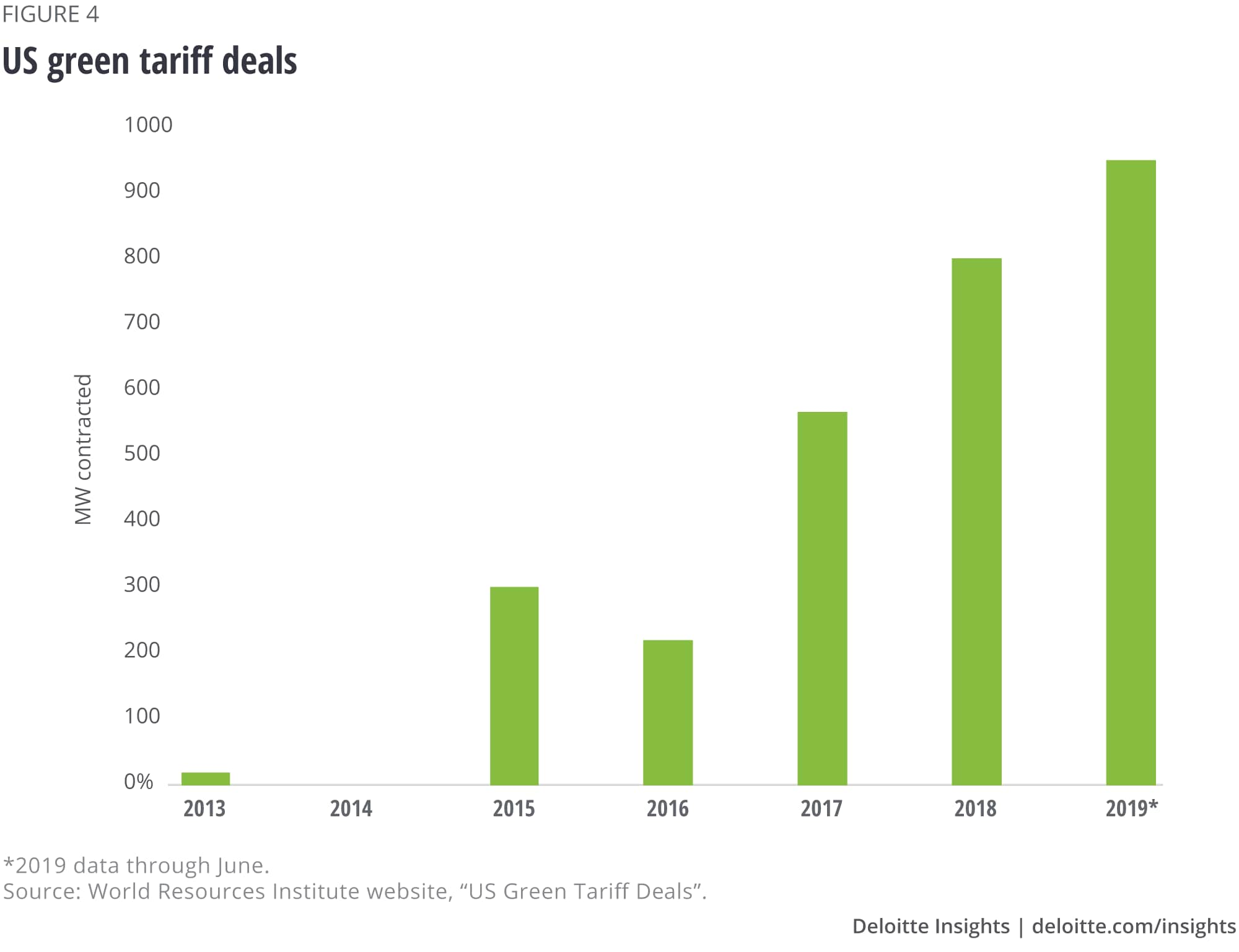
Some large technology companies are procuring renewable power through green tariffs by working with their utilities and regulators in regulated states. For example, Facebook recently worked with Pacific Power to use one of the utility’s previously negotiated green tariffs to support its data center in Prineville, Oregon with 100 percent new solar energy.30
Overall, while about 22 percent of survey respondents chose green power programs as one of the key renewable procurement practices, the technology and telecommunications group was one of the more frequent users of this tactic, at nearly 27 percent.
Community renewable energy options are expanding renewable procurement for new players
Driven by state policy, community renewable projects (also called shared renewable energy projects) enable local governments and communities to aggregate electricity demand within their jurisdictions and contract for renewable electricity supply. Nineteen states and the District of Columbia have policies and programs for community energy projects.31
While community solar was originally designed for residential customers, projects are now opening to corporate customers that seek to increase their involvement in green purchases. In March 2019, the Kansas City Board of Public Utilities opened its community solar farm, previously open only to residential customers, to commercial utility customers.32
The community solar tactic offers the potential for local companies to negotiate large renewable procurement contracts in aggregation with a group of residential customers and small businesses, often acting as an “anchor tenant.”
In 2017, organic farm cooperative Organic Valley committed to achieving 100 percent renewable power at its member facilities. It teamed up with UMMEG, a group of 15 Midwest communities, and OneEnergy Renewables to develop 31 MW of community solar projects.33 The projects were developed and are owned by OneEnergy Renewables, which sells the electricity generated to UMMEG for a fixed rate and subsequent sale to Organic Valley member farms.34
Organizations can participate in community solar in multiple ways—as a corporate sponsor (enabling employees to participate as subscribers), as an anchor tenant (which is the primary subscriber and agrees to buy the bulk of the power when higher-risk members enter and exit), as a site provider for a community solar project, or as the sole owner of the project. In June 2019, Walmart became an anchor subscriber to 36 of US Solar’s community solar gardens located throughout the state of Minnesota.35
Only about 11 percent of survey respondents chose this as a procurement option, which may be partly because many states have not yet developed policies for community energy programs. But the potential is high and this tactic will likely continue to grow.
Exploring the “What”
As organizations progress in their renewable energy transition, they may find that to boost the renewable share of their overall energy profile, they will need to electrify additional end uses, such as space and water heating, transportation, and industrial processes—and power them with renewables too.
Industry groups differ in the degree to which they use renewable energy in various end uses and their commitments to electrifying additional end uses. This sets each on its own path in the renewable energy transition and determines their placement in the 100 Percent Renewable Transition Framework (figure 3).
The education and government group stands out for the way many organizations have expanded their approach from the start. For example, in the education sector, many colleges and universities signed on early to a 100 percent renewable goal and more than 40 of them have already reached that goal.36
Many are leading by example in their holistic approach to the renewable energy transition by tackling other end uses beyond electricity, such as transportation and space and water heating.
Of 261 campuses that report their campus fleet details to a leading tracking organization, 88 percent have at least one electric vehicle (EV) and the top 10 schools in terms of EVs have converted over 60 percent of their fleets to electric.37 In February 2019, Florida State University announced it will decommission its entire fossil fuel-powered fleet and upgrade it to a 100 percent battery-electric fleet.38
Some campuses are also providing for building energy needs, such as heating and hot water, with on- and off-campus renewable energy sources, and some are deploying microgrids.
In September 2018, the University of California announced a new sustainability goal: to achieve 100 percent clean electricity across its campuses and medical centers by 2025. No new UC buildings or major renovations after June 2019, except in special circumstances, will use on-site fossil fuel combustion, such as natural gas, for space and water heating.39
Three developing themes within the set of “What” strategies are:
Electrifying corporate fleets likely represents the biggest opportunity
The transportation sector may hold the most promise for electrification. It accounted for 28 percent of US energy use in 2018, yet was less than 3 percent electrified, and that included all EVs, mass public transit systems, and other uses.40 In the United States, the commercial sector has a fleet size of 613,000 cars and 2,546,000 trucks, and the government has 1,236,000 cars and 1,898,000 trucks.41
Organizations globally are supporting transportation electrification through various strategies. These include integration into directly owned fleets, increasing EVs in rental service contracts and sharing platforms, and supporting EV uptake by staff and customers. The number of organizations committing to the EV100 coalition, a global initiative to accelerate the transition to EVs, has doubled from 26 members in 2017 to 52 members in 2019.42
According to our survey, 63 percent of surveyed respondents have transportation fleet electrification plans. Key challenges to EV adoption among our survey respondents are their high purchase cost compared with internal combustion engine (ICE) vehicles and lack of charging infrastructure. Forty-six percent of respondents selected these as reasons for not having any transportation electrification plans (figure 5). Another 54 percent of respondents noted a lack of funding and incentives such as tax credits and rebates.
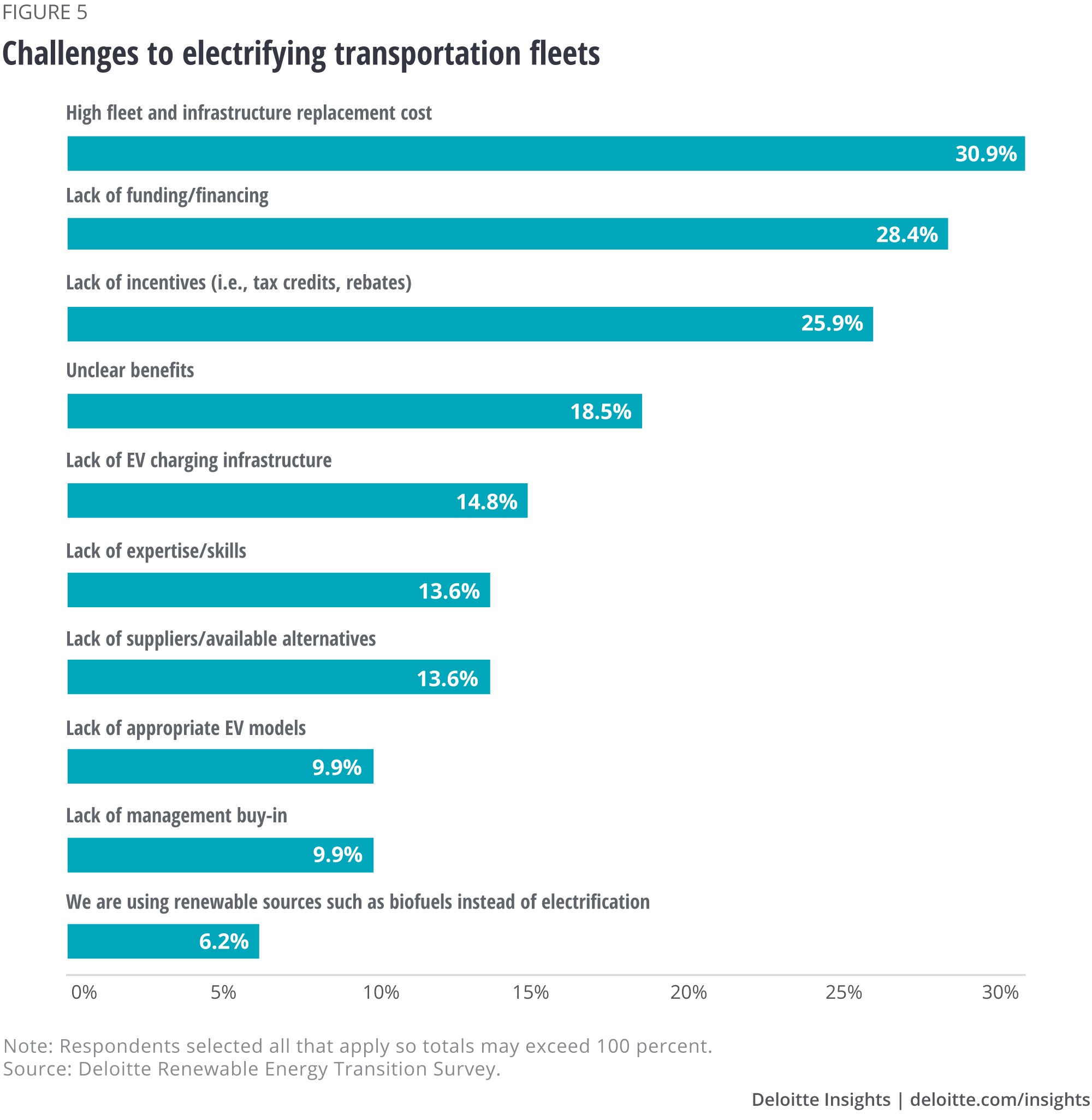
However, with battery costs plunging, new EV models are approaching price parity with ICE vehicles. Lower fuel and maintenance costs already make the life cycle cost of ownership lower than ICE models in many cases—and even more so at scale for large fleets.43
Combine these increasingly competitive costs with the rising number of models available, and more companies will likely begin to see the business case for switching.
Space and water heating electrification typically makes more economic sense for new buildings than existing infrastructure
Space and water heating in buildings is a growing target for electrification, as it is the largest energy end use in buildings and it currently contributes more than two-thirds of total greenhouse gas emissions for the building segment.44 Space heating is dominated by nonelectric fuels, such as natural gas.45 This highlights the potential to convert to electric heat, and power it with renewables.
Such intentions are most prevalent in the health care/medical group, with 87 percent of respondents reporting plans to electrify space and/or water heating, while 82 percent of those in the technology and telecommunications group reported such plans.
Short-term electrification opportunities include converting gas-powered furnaces and water heaters to electric heat pumps and water heaters.46 However, nearly 33 percent of respondents identified the cost of retrofit as a challenge to electrifying space heating (figure 6). They also identified funding and lack of incentives as key challenges to conversion.
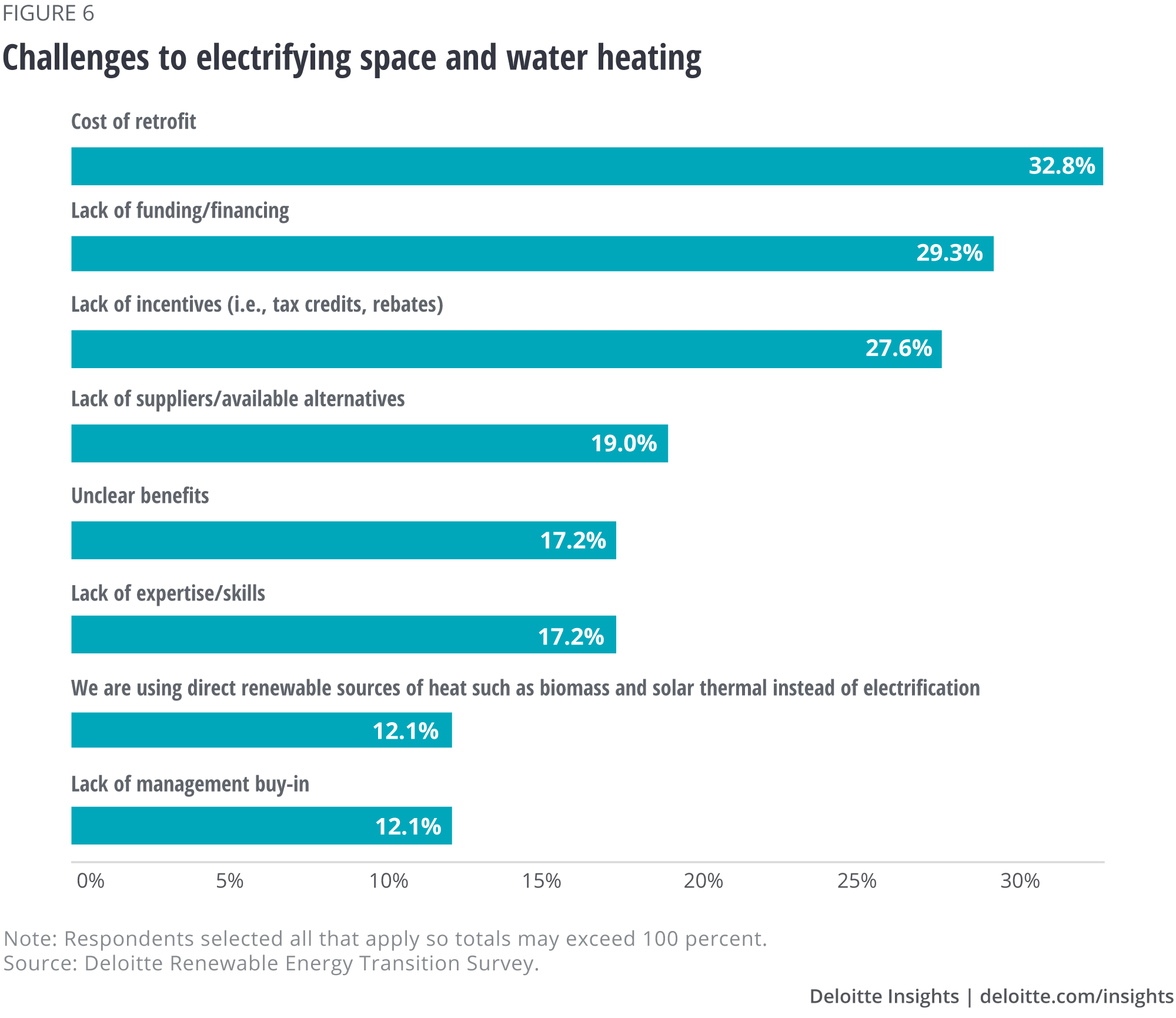
Studies show the cost of space heating system retrofits can be prohibitive, which makes the switch more feasible in new construction.47 In addition, electric heat pumps are currently more appropriate for regions with milder winters since they become less efficient at subzero temperatures.48
Electric water heaters, however, are less expensive to purchase and install than space heating, making the swap less difficult. In addition, electric water heaters can increasingly participate in utility demand response programs, which can create value for the customer and add flexibility to the grid.
Interest in electrifying industrial processes exists, though challenges remain
Many industrial end users seek to electrify industrial processes and power them with renewables, or power them directly with renewable sources.
Industrial processes use energy for several purposes, including process heating, conventional boiler use, and combined heat and power systems. Among these, process heating is approximately 75 percent of energy use and more than half of it is at low-to-medium-high temperatures. However, only 5 percent of process heating makes up electrified.49
Approximately 45 percent of industrial heating demand is for low-heat processes, typically below 200 degrees Celsius.50 These processes used in industries such as paper, pulp, and food and beverage could be well suited for electrification, which could be powered by renewables. Some medium/high-heat processes (<400 degrees Celsius) are also being electrified with efficient heat pumps and resistance heating.
But high-heat processes such as those used in the cement and glass industries are harder to electrify. In these cases, renewable heating technologies can be used effectively in the preliminary heating process and reduce conventional industrial heating needs. Flat-plate solar collectors using solar thermal energy and ground source heat pumps can support this preheating requirement.51
However, some emerging electric technologies, such as hydrogen-based direct iron reduction for steel production, infrared and ultraviolet heating, induction melting, and electric boilers, hold potential for industrial electrification.52 Any assessment of the potential of industrial electrification must be specific to the application it addresses.53
In addition, remote industrial sites that require shipping in large volumes of fuel may be good candidates for conversion to solar or wind power. Some mines, for example, are deploying renewable energy. Rio Tinto’s Diavik Diamond Mine in Canada’s Northwest Territories has been operating a 9.2 MW wind-diesel hybrid facility to generate power and reduce carbon emissions since 2012.54
According to our survey, high replacement costs for many industrial processes are also hindering electrification plans, with about 46 percent of respondents citing that as a challenge (figure 7). Other key reasons include the lack of management buy-in, equipment suppliers, and internal expertise.
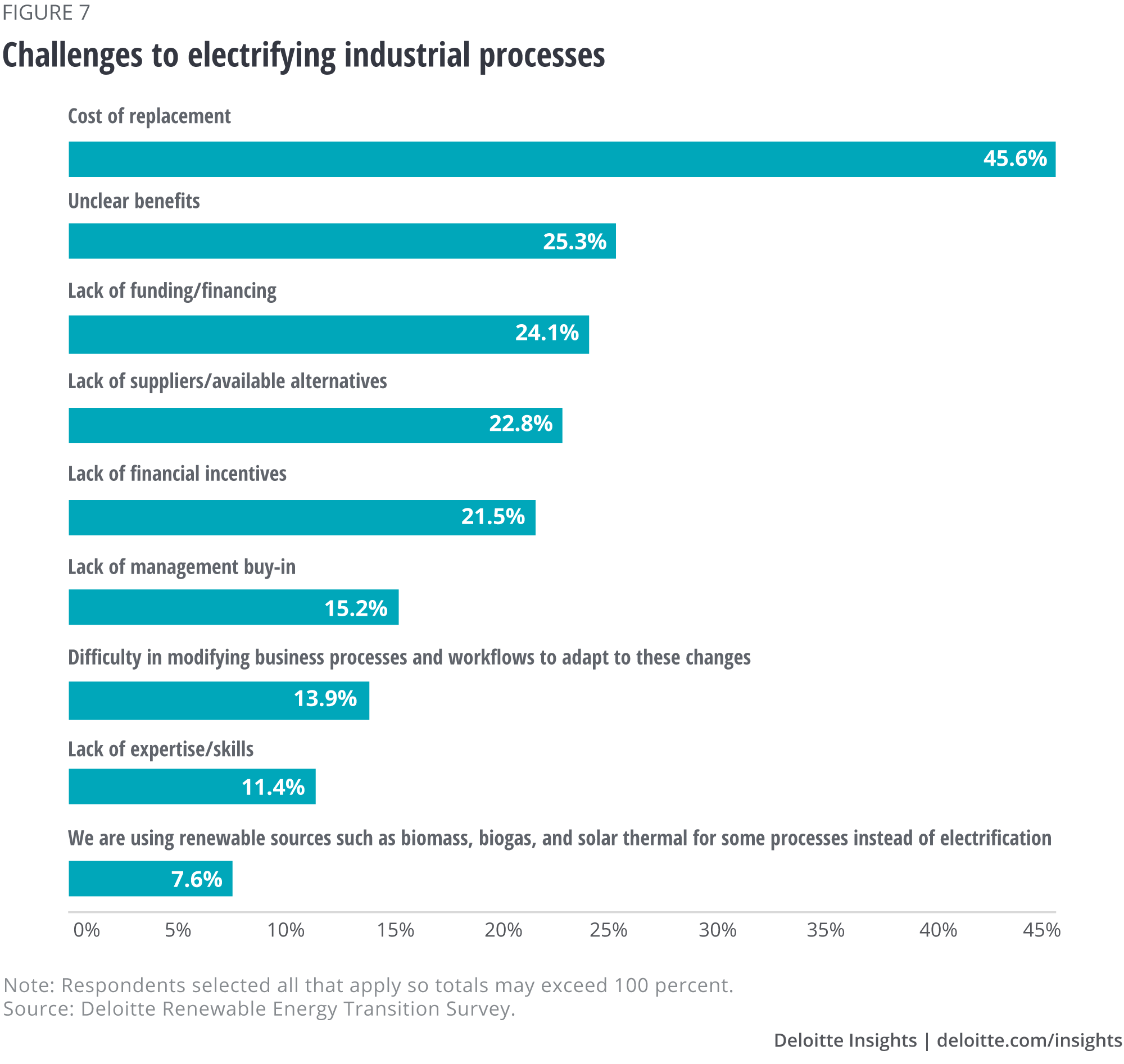
Addressing key challenges could advance the transition
Organizations surveyed rated the key obstacles to both boosting their renewable energy use and further electrifying end uses. The top challenges that emerge are renewable resource availability and access, the cost of EVs, difficulty attracting talent with the right skills, and the intermittent nature of wind and solar (figure 8). Access and cost are becoming less challenging as costs continue to fall for renewables and EVs, new renewable procurement avenues open, and more EV models are launched.
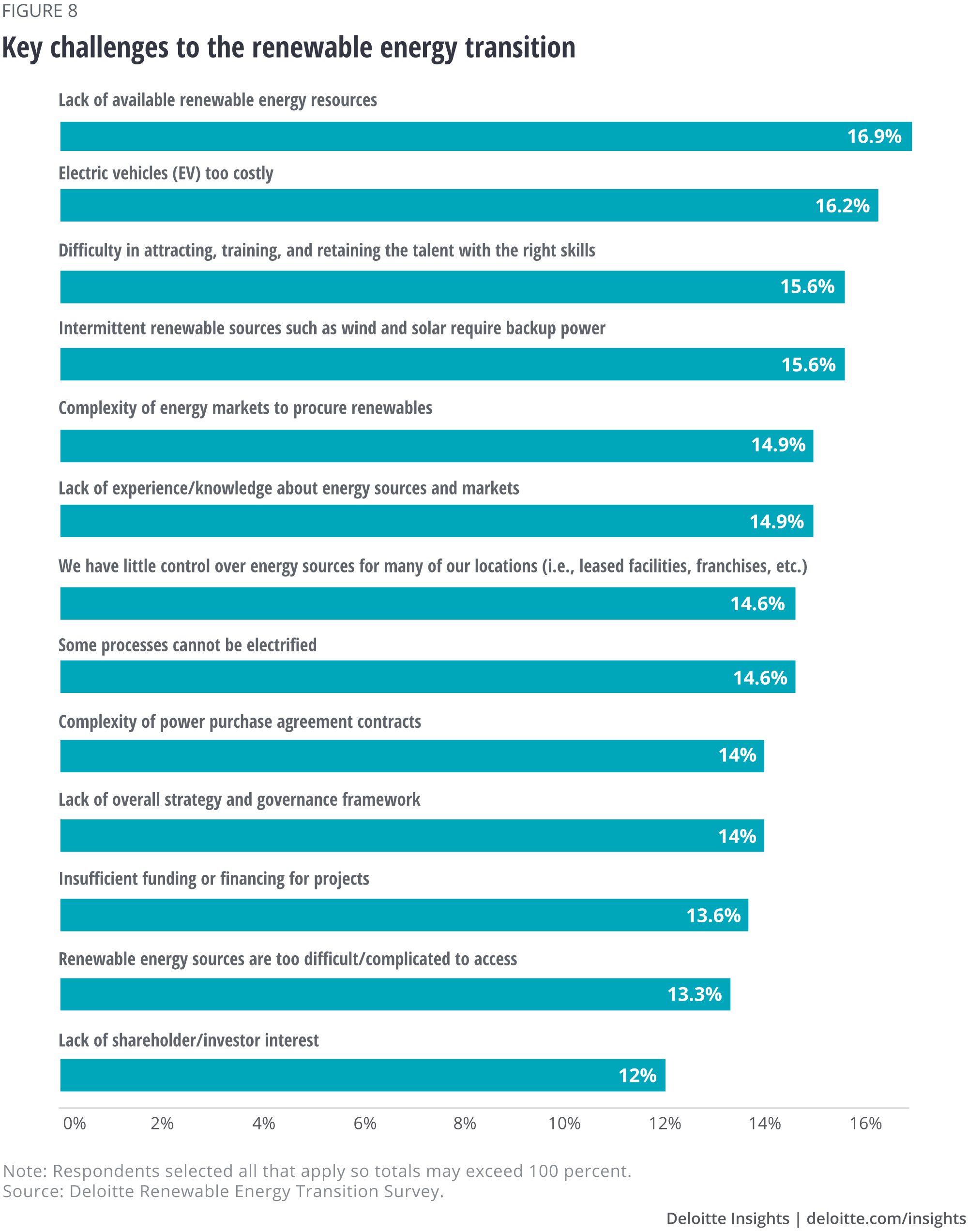
Respondents also noted the complexity of renewable procurement and their lack of experience, knowledge, and skills to purchase and manage these resources. These issues relate back to their challenges in attracting skilled talent that could help them make decisions to access available renewable resources. An overall strategy framework backed with funding would also be required, and some respondents noted that was lacking as well.
Electric utilities have the opportunity to play a significant role in helping organizations address some of these challenges and navigate the renewable energy transition to meet their goals.
Utilities can be key enablers in the 100 percent renewable transition
Survey respondents rated “coordination with our electric utility” as the primary external enabler of the progress they’ve made in advancing their renewable or clean energy goals (figure 9). In fact, utilities can directly influence the pace and scale at which these organizations can reach their energy goals.
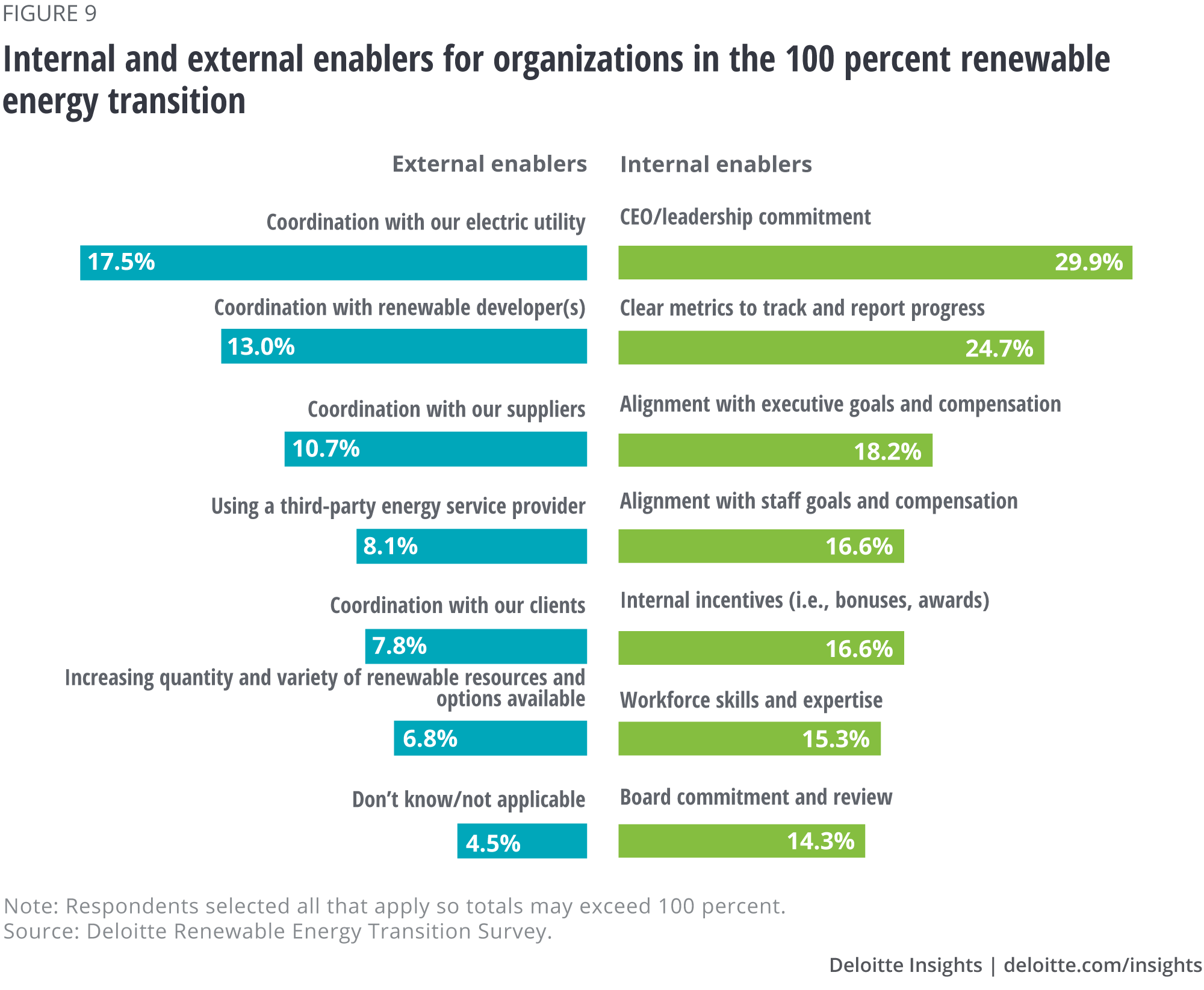
Noting their customers’ growing demand for renewable electricity, utilities are increasingly boosting the role of renewables in their long-term resource plans. Many also see electrification of additional end uses as a significant opportunity and have begun promoting the transition, particularly in the transportation sector.
Utilities are already playing multiple roles to enable the transition to 100 percent renewable energy. And there are additional roles they can play in the future (figure 10).
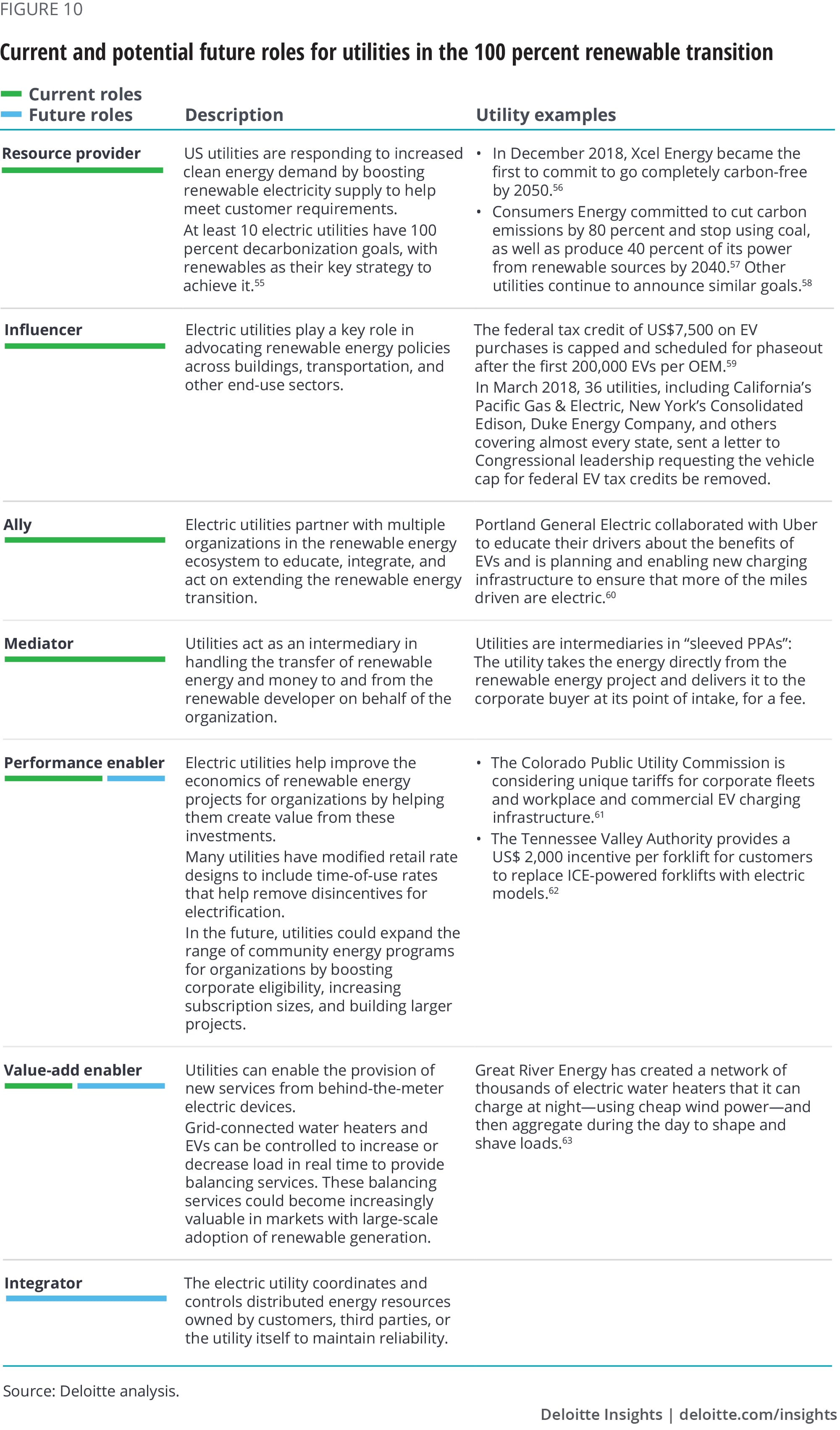
Broader ecosystem factors also play a role in the 100 percent renewable transition
While electric utilities can play a direct role in enabling organizations to transition to 100 percent renewables, factors in the broader ecosystem must also evolve to accelerate the transition. Policy initiatives and technological advances are two of the most important factors respondents said would help them reach renewable energy goals (figure 11). Beyond that, expanding access to renewable resources was cited as critical, whether it’s through new transmission lines connecting wind and solar plants to electricity demand centers, or new financing and market structures to ease procurement.
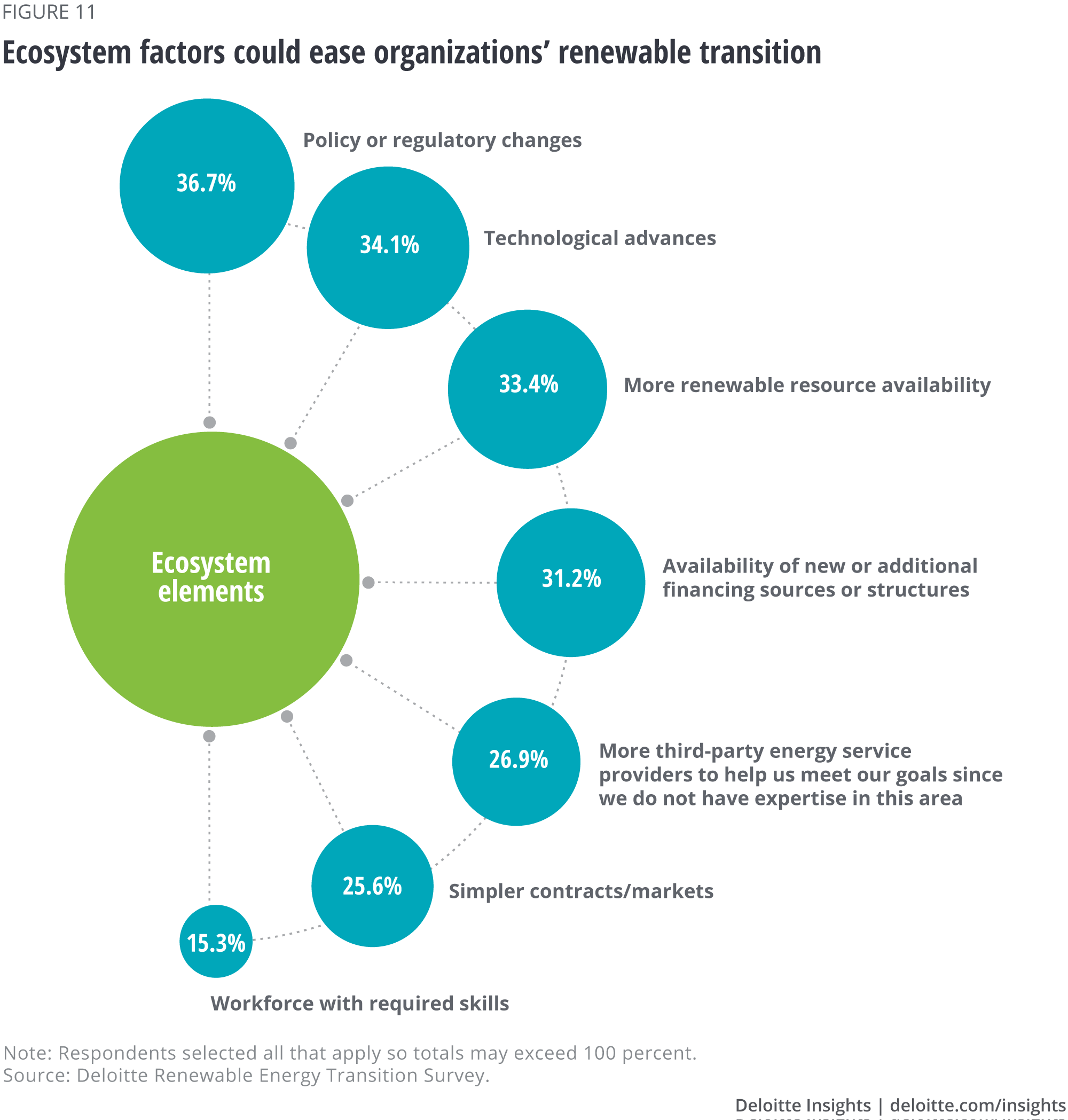
In the policy realm, a coordinated national US energy policy putting a price on carbon would be one of the strongest enablers for the 100 percent renewable movement. Extending existing renewable and EV-friendly federal policies such as tax credits for wind, solar, energy efficiency upgrades, EVs, and EV infrastructure could also help, as could expanding tax credits for energy storage technologies. However, a carbon tax is unlikely to be enacted in the current political climate, and the fate of the other proposals is currently unclear.
So, for now, the 100 percent renewable movement may continue to depend heavily on state initiatives, such as increased renewable portfolio standards (RPS), the zero-emission vehicle (ZEV) program, regional carbon cap and trade programs, and potential carbon pricing schemes in wholesale markets such as New York’s Independent System Operator (NYISO).64 In addition, the movement depends on cities with ambitious renewable energy and decarbonization goals continuing to collaborate with corporations, states, citizens, utilities, and other stakeholders on policies and programs to reach their goals.
Technological advances in many areas would also help expedite the 100 percent renewable transition. And the technology with the most impact would likely be long-duration battery storage. The maximum battery storage duration is typically four to six hours. But research into long-duration energy storage technologies aims to provide electricity for 10 to approximately 100 hours reliably and affordably.65 This would enable intermittent wind and solar resources to act more like baseload power sources such as natural gas. The United States deployed 311 MW of energy storage in 2018, which is expected to double in 2019. The current market size of roughly US$1 billion is projected to reach almost $US5 billion by 2025.66 Other technologies ripe for advances are those that could enable economic electrification beyond the power and transportation sectors, such as in industry, aviation, shipping, heating, and agriculture.67
The next five ecosystem factors respondents said could ease their renewable transition journeys are related: greater availability or access to renewable resources (33.4 percent), finance and funding (31.2 percent), simpler market structures (25.6), third-party expertise (26.9 percent), and a workforce with required skills (15.3 percent). For those who seek greater access to renewable energy, the new and expanding procurement methods discussed previously, such as aggregated PPAs, green tariffs, and community energy, may begin to open options, as would some of the following developments.
On the financing front, capital expenditures for renewables, EVs, building retrofits, and other options can be prohibitive, even though life cycle costs may be much lower than conventional alternatives due largely to lower fuel costs. That’s why the solar and energy efficiency industries developed financing models based on future energy savings. Expanding this concept to cover additional transition-related services, enabling further customer aggregation and scale, and bundling services at a fixed subscription price could begin to address some of these issues. Wrapping such services into energy-as-a-service packages could also address respondents’ desire for simpler markets and access to third-party expertise or a skilled workforce to help with energy decisions. This could be an opportunity for utilities and other experienced players to step in.
Conclusion
The renewable energy transition has taken root and is poised to accelerate in the United States. Key drivers are strengthening and goals are becoming more ambitious. But today’s goals are just the tip of the iceberg. The commercial, industrial, and transportation sectors make up almost 80 percent of US electricity demand.68 And most organizations need access to more renewable resources before they can realistically target 100 percent renewables. Many also need more economical ways to electrify additional end uses, such as industrial processes.
The top two drivers of the renewable transition based on our survey are cost-cutting and reducing environmental impact/carbon footprint. Cost-cutting opportunities are expected to continue to rise as wind and solar prices fall. And reducing environmental impact will likely remain a priority as stakeholder pressure expands. Customers, employees, citizen activists, and the general public have sounded the call for some time. More recently, capital markets are joining in. Sharpening focus on carbon intensity and its inherent risks—from investors, regulators, insurers, and, most recently, credit rating agencies—is adding urgency for many businesses.
Well over half of our survey respondents have concrete goals to boost the renewable (44.8 percent) or “clean” (24 percent) energy share of their electricity use—and a quarter aim to reduce carbon and other greenhouse gas emissions, putting renewables squarely on a growth trajectory. And 2 percent are targeting 100 percent renewables. For many organizations, 100 percent renewables will remain an aspiration until more wind and solar energy is available and easier to access and store.
More than 200 companies had joined the global RE100 by the end of September 2019.69 These companies have committed to match 100 percent of their global electricity use with electricity produced from renewable sources by no later than 2050. Based on the group’s targets, BloombergNEF says they’ll face a collective shortfall of 189 TWh of renewable electricity in 2030.70 This would catalyze an additional 94 GW of global renewables build if the companies meet the shortfall through solar and wind PPAs, leading to US$97 billion of new investment, BloombergNEF projects.71
These challenges create opportunities for electric utilities, which can play multiple roles to ease the transition for organizations by using their expertise, data, reputation, and access to low-cost capital. Actors in the wider ecosystem can also play a role. Those with the resources and expertise can bundle and scale energy services to help organizations across many industries. By doing so, they can ease the transition and help organizations turn 100 percent renewables from an aspiration to a destination.
Appendix
Industry group definitions
The survey population is split into the following industry groups, with each composed of related industries*:

© 2021. See Terms of Use for more information.
Read more on Power & Utilities
-
Managing cyber risk in the electric power sector Article6 years ago
-
Big-picture thinking on innovation in the retail power sector Article6 years ago
-
Digital innovation Article6 years ago
-
Powered by blockchain Article6 years ago
-
Powering the future of mobility Article7 years ago
-
The carbon-neutral utility Article7 years ago















